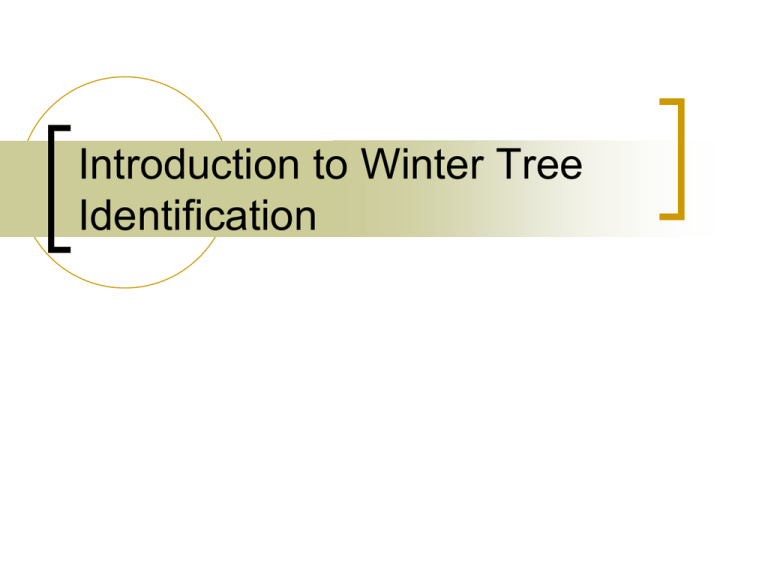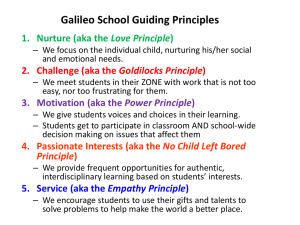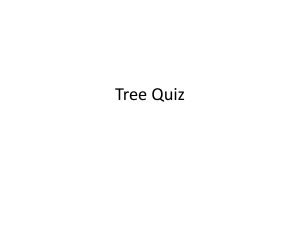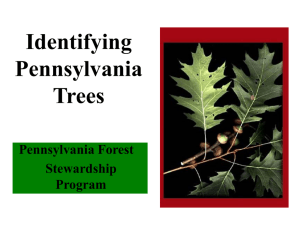Introduction to Forestry
advertisement

Introduction to Winter Tree Identification Coniferous Trees These are trees that hold on to their leaves all year round. Their leaves are needle or scale-like. These forests are home to many fur-bearing animals. Alternate names: Evergreens Softwoods Coniferous Trees Needle-like leaves Scale-like leaves Deciduous Trees These are trees that lose their leaves in the winter. These trees are harder in density, and are used for furniture and flooring. A hardwood log will burn longer and hotter than a softwood log. Alternate names: Hardwood Broad leaved trees How to identify a tree? Learn the tree identification features Know your environment or habitat Wetland, upland, soil type Use a tree identification key Determine whether coniferous or deciduous. Check to see bud or leaf arrangement Tree Identification Features 1. 2. 3. 4. 5. 6. 7. 8. Leaf, needle, scale-like leaf Twig and bud Bark Size and form Shade tolerance Seed Wood Region and habitat 1. Identifying by the leaf A: Leaf type B: Arrangement on twig C: Leaf shape D: Leaf margin A: Leaf Types Compound vs. Simple Scale-like Needles In bunches of 5 In bunches of 2 Simply on twig A: Leaf Type Simple undivided Compound Divided into leaflets A: Leaf Type Scale-like Needles In bundles of 5 In bundles of 2 Singly on twig B: Leaf Arrangement Alternate Opposite Leaves grow alternately on twig Leaves grow opposite of each other on twig Whorled Leaves grow in a circular fashion on the twig C: Leaf Shape oval reversed oval linear heart-shaped cordate cuneate D: Leaf Margins Smooth Toothed Wavy or lobed 2. Twig and Buds Twig with opposite bud arrangement Twig with alternate bud arrangement Conifer twig 3. Bark Varies by age and growth rate Identifying features: Colour Structure (flaky, smooth, rough) Pattern (fissured, furrowed, flat ridges) 4. Form or Shape Form refers to the shape of the crown, the branches and the trunk. Each species has a characteristic form when grown in the open 5. Shade Tolerance All tree species have a tolerance level for shade. Intolerant Intermediate Species that cannot survive in shaded conditions. They need direct sunlight to grow. Species that can survive in partially shaded conditions. Tolerant Species that can live in shaded conditions Shade Tolerance Chart Tolerant Intermediate Intolerant Hemlock White pine Red pine Balsam fir Yellow birch Walnut Ironwood Oak Butternut Beech Elm Hickory Sugar maple Ash White birch Spruce Black cherry Cedar Tamarack Red maple Jack pine Silver maple Willow Basswood Aspens Poplars Grey birch 6. Region & Habitat Soil structure, water conditions and sunlight all have an impact on species of trees growing in a region Examples: Bog – black spruce, larch Upland, rocky terrain – sugar maple, hickory, beech, red oak, jack pine Clay loam field – ash, basswood, elm Coniferous AKA: Evergreens, softwoods, needle-bearing trees Class: Magnoliopsida Division: Pinophyta Coniferous leaf Needles Clusters of 2, 3 and 5 needles per bundle Scales Usually flat Waxy Short needles or scales In opposite or whorls Eastern White Cedar Thuja occidentalis L. AKA: Northern white cedar, eastern thuja, eastern arbovitae Needles Bundles of 2, 3 and 5 Eastern White Pine Pinus strobus L. AKA: northern white pine, weymouth pine The only 5 needle pine in Eastern Canada. Red Pine Pinus resinosa Ait. AKA: Norway pine The only native 2 needle pine in eastern Canada with long needles Tamarack Larix laricina (Du Roi) K. Koch AKA: Larch Has tufts of soft needles in summer, leaves turn brilliant yellow in fall and trees become leafless in winter. Single, flat or 4-sided Balsam Fir Abies balsamea L. AKA: Canada balsam White Spruce Picea glauca (Voss) AKA: Cat spruce, skunk spruce, pasture spruce, Canadian spruce Eastern Hemlock Tsuga canadensis Carriere Deciduous AKA: broadleaf, hardwoods, flowering trees Division: Magnoliophyta Class: Magnoliopsida Opposite pairs Two leaves or buds are positioned on opposite sides of the stem Sugar Maple Acer saccharum Marsh. AKA: Hard maple, rock maple Silver Maple Acer saccharinum L. AKA: Soft maple Red Maple Acer rubrum L. AKA: Swamp maple, soft maple White Ash Fraxinus americana L. Compound leaf Leaves alternate & compound Butternut Juglans cinerea L. AKA: White walnut Leaves alternate and simple Edges lobed Bur Oak Quercus macrocarpa Michx. AKA: Blue oak, mossycup oak Leaves alternate and simple Edges toothed Basswood Tilia americana L. AKA: American linden White Birch Betula papyrifera Marsh. AKA: Paper birch, canoe birch Leaves alternate, simple, edges smooth Bud arrangement Winter Tree ID Key Take a few minutes to go over your handout. Highlight the important aspects, in order to help you differentiate types of trees. Feel free to add notes. Sometimes coding helps the memory. Activity – Name that tree As a group, your objective will be to use your handout in order to name the type of tree displayed on each slide. READY? 1) Name that tree… 2) Name that tree… 3) Name that tree… 4) Name That Tree… 5) Name That Tree… 6) Name That Tree… 7) Name That Tree… 8) Name That Tree… 9) Name that Tree 10) Name That Tree… 11)Name That Tree… 12) Name That Tree… 13) Name That Tree… 14) Name That Tree… 15) Name That Tree… Final Score!!! And the winner is…








